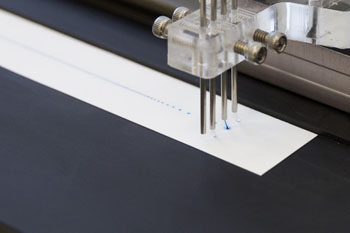New Technique May Provide Low-Cost Pathogen Testing
By LabMedica International staff writers
Posted on 12 Jul 2016
Researchers are developing a rapid pyrogen-detection stick-test for detecting presence of pathogens and allergens. The test has potential applications in clinical diagnostics as well as in food, pharmaceutical, and hospital environment testing. Posted on 12 Jul 2016
Currently pyrogens (fragments of pathogens) can only be detected with laboratory equipment that makes testing costly and laborious. A widely used standard test is the detection of LPS, a structure that is present in the membrane of certain bacteria. At present this test takes around 2 hours. Some pyrogens can even only be detected in animal experiment.

Image: The production of ImmuStick, showing the application of immune receptors onto the test strip (Photo courtesy of Fraunhofer IGB).
Researchers at the Fraunhofer Institute for Interfacial Engineering and Biotechnology IGB (Stuttgart, Germany) are developing a rapid and cost-effective test, ImmuStick, which can be carried out directly in situ without laboratory equipment and specialist knowledge.
“The ImmuStick can even detect pathogens outside the body – on medical devices or in hospital rooms for example. However, the technology would certainly also be of interest for testing human blood for germs or allergies,” said Dr. Anke Burger-Kentischer. Working as simply as a pregnancy test, ImmuStick is a test strip onto which a few drops of sample fluid are applied. If the fluid contains pyrogens, this is indicated by a color in a viewing window.
Feasibility was demonstrated using an ImmuStick with immune receptors specific for testing samples for the bacterial pyrogen LPS. “We were able to show that it works very well,” said project manager Dr. Burger-Kentischer, “Together with industrial partners, we now want to develop it into a product, [and] we are currently testing further immune receptors that are specific for other pyrogens.“
ImmuStick is of interest for blood analysis as pyrogens in the blood often lead to sepsis. “However, blood is a special challenge as it is complex and contains many constituent parts. But in the medium term we are aiming at blood analysis,” said Dr. Burger-Kentischer.
Also envisaged are applications outside the clinical lab sector. Pyrogens include certain allergy trigger factors and can be a problem where hygiene is of particular importance, so ImmuStick could be used in the food and pharmaceutical industries as well as in hospitals on, for example, intensive care wards. Costly and laborious laboratory tests would therefore no longer be needed or could be supplemented. The IGB researchers are seeking cooperation partners to help further develop ImmuStick.
Related Links:
Fraunhofer Institute














